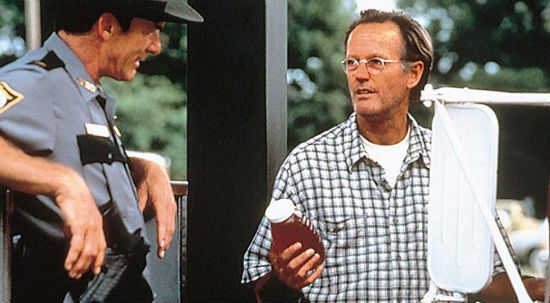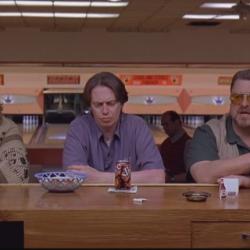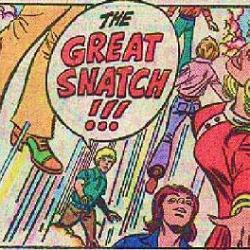Originally posted March 8, 2010.
You can read this entire series, for free, via the convenient Left Behind Index. The ebook collection The Anti-Christ Handbook: Volume 1, is available on Amazon for just $0.99. Abolish ICE, indict the Border Patrol. Volume 2 of The Anti-Christ Handbook, completing all the posts on the first Left Behind book, is also now available. Volume 3 is coming someday.
Tribulation Force, pp. 169-172
To kill time waiting for Chloe to arrive, Buck Williams browses the bookshelves of the “sitting area outside Bruce’s office.” There he stumbles across “a church photo directory dated two years earlier.”
Tribulation Force-typist Jerry Jenkins fumbles this, but let’s first commend what we can here. First, Jenkins decides to take this moment of downtime before Chloe’s arrival as an opportunity to explore some sorely neglected character notes. That’s a positive step — particularly in a series of books in which the authors usually sit around waiting along with their characters. And the device of this photo directory — a kind of yearbook — gives Jenkins the chance to make up for his failure thus far to tell us what his characters actually look like. More than 600 pages into this series, readers wouldn’t be able to sit down with a sketch artist and provide even the broadest sense of our core heroes’ appearance.
Buck turns to the picture of:
… a younger, longer-haired Bruce Barnes. He looked a bit fuller in the face, wore a pasted-on smile, and surrounding him were his wife and children. What a treasure Bruce had lost! His wife was pleasant looking and plump, with a weary but genuine smile.
So now we know that Bruce has shorter hair and a leaner face than he used to have. We know that he had three children (unnumbered and unnamed here) but, despite the captioned photo on the page Buck is reading, we still don’t know their respective names, ages or genders. And we’ve now learned that the undead former Mrs. Barnes doesn’t tempt Buck to violate the 10th Commandment. (I’m trying to recall the last time I heard someone use the term “plump” to describe anything other than a Ballpark Frank or a Thanksgiving turkey.)
On the next page was Dr. Vernon Billings, the now-departed senior pastor. He looked at least in his mid-sixties and was shown with his petite wife and three children and their respective spouses. Bruce had already said that the entire family had been raptured. Pastor Billings had a Henry Fonda-ish quality, with deep crow’s feet and a crinkly smile. He looked like a man Buck would have enjoyed knowing.
It’s odd to read of Buck’s first visual impression here of Billings, since he spent quite a bit of the previous book carefully watching a long video of Billings’ In-Case-of-Rapture sermon, but Jenkins seems to have belatedly realized that despite the prominence of that video in Book 1, he neglected to offer any description of the man on the tape. This is one of the most detailed descriptions we get of any character in this book — probably second only to that of Nicolae Carpathia. Neither description is really all that detailed, but most readers will have an idea of what “a young Robert Redford” or a 60-something Henry Fonda (think Once Upon a Time in the West, not The Grapes of Wrath or On Golden Pond — and if you haven’t seen all of those, you should) looks like and that gives us a clearer picture than we have of either Rayford or Buck.
I’m not entirely opposed to the idea of describing characters in terms of famous actors or other celebrities. This is something real people in real life do all the time. It can be a useful short-hand starting point — a common reference from which we can go on to qualify the description. But we need to go on and qualify the resemblance or else we leave people with the mental image of a celebrity impersonator rather than a useful description. “A Henry Fonda-ish quality” isn’t, in itself, a bad phrase, but without more than Jenkins gives us to go with it, I’m now picturing Pastor Billings as Ulee Jackson.

Buck looks up the Steeles in the church directory:
There was Rayford in his pilot’s uniform, looking pretty much the same as he did today with perhaps slightly less gray in the hair and a little more definition in his face.
So now we know what Rayford looks like: He looks two years older than he did two years ago. And he’s the kind of guy who poses for family and church photos in his uniform from work, but we already knew that about “Captain” Steele.
Irene Steele, Buck sees:
… looked bright and cheery, and if you could believe the faddish study of photo-psychology, she appeared more devoted to her husband than he did to her. Her body leaned toward him. He sat rigid, straight up.
I’ve never before seen it referred to as “photo-psychology,” but the “fad” Jenkins refers to goes back to those trendy pre-photographic painters who believed they could create what they called “portraits” of their subjects — images that conveyed character and personality, not just what someone looks like, but who they were. I actually believe in this faddish notion — as does every photographer who doesn’t work for the DMV or the glamour shots place at the mall.
Portraits that capture the character of their subjects are what photographers and painters are supposed to produce. They’re also what novelists are supposed to produce. And Jenkins here shows us something like such a portrait in the last two sentences of the paragraph above: “Her body leaned toward him. He sat rigid, straight up.” But Mr. Tell-Don’t-Show can’t let that evocative glimpse of character stand alone. He has to smother it with an explicit interpretation telling us what it means — “she appeared more devoted to her husband than he did to her.” And he can’t help but further squelch its impact with an awkwardly dismissive, mocking introduction — “if you could believe the faddish study of photo-psychology.”
This is Bad Writing, of course, but note again that it’s a very particular kind of Bad Writing. It’s distrustful of metaphor, preferring explicit, singular meaning over implicit and dangerously open-ended or ambiguous visual symbols. A picture may be worth a thousand words, but the reader can’t be trusted to find in that picture only the particular, official, authoritative thousand words intended by the authors, so it’s safer to tell rather than to show.
In other words, Jenkins’ Bad Writing seems to be a consequence of, or at least a corollary to, his “literalist” hermeneutic. If you can’t read a parable without reducing it to a single, linear, propositional “meaning,” then you probably can’t write a parable either. And vice versa. Parables (parabolas) defy such linear thinking. But to Jenkins the idea that a story or a poem or a portrait or an allusive, symbol-ridden apocalyptic vision might mean and contain and entail more than a single, propositional meaning is “faddish” nonsense, just like the “study of photo-psychology.”
So poor Jenkins, theologically and philosophically unable to tell a story as a story, rushes onward to reach the Message of Buck’s interlude with the church’s photo directory:
Also in the picture was Rayford Junior, identified in the caption as “Raymie, 10.” He and his mother had asterisks by their names. Rayford did not. And neither did Chloe, who was listed as “18, Freshman, Stanford University, Palo Alto, California (not pictured).”
Buck flipped to the legend, which explained that an asterisk indicated a church member. The rest, he assumed, were mere attenders.
Do you see, dear reader, what becomes of those content to be “mere attenders”? Irene and Raymie were members — real, true, Christian members — and they were whisked off to paradise, freed from the suffering, wrath and judgment to come. But proud Rayford and his egghead daughter were mere attenders. They were left behind to face all the torments of the end of the age.
This is the focus of the series’ evangelistic message, such as it is. That message isn’t aimed at the “unsaved,” but rather at those who may be worrying about the sufficiency of their own passionate sincerity. You go to church every Sunday and you say you’re a Christian — but are you really? Can you be sure? That sort of thing. Not a call to conversion, but a call to re-conversion, or to the recertification of a pre-existing conversion. In the parlance of evangelical altar calls, an invitation to “re-dedicate your life to Christ.”
Such “re-dedications” are the bread and butter of a great many professional evangelists working and reworking the Burned Over District of the evangelical subculture. That may account for the curious fact that the number of evangelical Christians in America has been more or less constant for years despite the many millions who have “come forward” at evangelical altar calls.
Anyway, speaking of altar calls: Mere attenders were left behind, the authors warn. Now, with every head bowed and every eye closed, we invite anyone who may be less than 100-percent certain that they are more than mere attenders to come forward. As the worship band softly plays “I Wish We’d All Been Ready,” ask yourself: If the Rapture happened right now, this very day, is there any chance that you might be left behind? We’re going to keep our heads bowed and our eyes closed and the band is going to keep playing that song over and over and over and over until we get a respectable head-count up here in front of the podium. …
Jenkins was so determined to get to this Message that he trampled all over his story getting there.
Consider Buck’s alleged state of mind when he picked up that church directory. He’s just rushed halfway across the country with only one thought in mind — Chloe. He’s smitten. He’s only just realized this himself thanks to his first-ever non-bathroom epiphany which came, inconveniently, in the middle of his life-or-death conversation with the most powerful man on earth. It hit him so hard that when the embodiment of pure evil offered him a job, the only response he could think to stammer was to stipulate that he would need to be based somewhere near Chloe.
Now, if someone so love-besotted were to find, while waiting for his beloved to arrive, a photo directory of her church, there’s no way he’d waste time turning to look at pictures of Bruce or Billings before flipping directly to the one face he longs to see.
Mercifully, Chloe was away at school on photo day, so we’re spared the creepy sight of Buck reacting to a picture of her as she appeared six months after her prom. But everything about his scrutiny of the Steeles’ family photo is all wrong. He studies Rayford, then Irene, then Raymie before even noticing Chloe’s absence from the photo. And upon seeing Irene and Raymie for the first time, he doesn’t think of Chloe’s loss and the pain she must be feeling. Less nobly, he doesn’t scrutinize the first photo he’s ever seen of Irene, looking for traces, good or bad, of what Chloe might come to look like in a few years. I suppose Buck doesn’t have to worry too much about that, since he knows his new girlfriend is doomed never to age beyond about 27, but still, one wonders how he might have reacted had it been Irene rather than Mrs. Barnes who appeared a bit “plump.”
Instead of feeding his supposed infatuation with Chloe, Buck’s discovery of this old yearbook elicits from him only a reverent meditation on the wretched state of the mere attenders who were too foolish to heed the One True Gospel of LaHaye until it was too late. People in love don’t act like this.
Buck sees Chloe’s car arrive and he races to the front door of the church to greet her and walk her in. His overeager enthusiasm hadn’t gone over well on the phone, but he thinks it might work better in person.
As soon as Buck stepped out the door, Chloe emerged from the car and hurried toward the church. “Hey!” he said.
“Hello, Buck,” she said, clearly without enthusiasm.
“Flowers still in the trash?” he tried, hoping for some clue to what was up with her.
“As a matter of fact, they are,” she said, brushing past him and opening the door herself. He followed her up the stairs, through the foyer and into the offices.
I can’t help but wonder how Buck expected that line to go over. After his rehearsed half-witticism flops, he’s finally able to notice that Chloe seems upset.
Obviously Chloe would rather be anywhere but there and looking at anything but him. She had been crying, and her face was red and blotchy. He ached to reconnect with her. Something told him this was not just a mood, a part of her personality he would have to get used to. Something specific was plainly wrong, and Buck was in the middle of it.
Buck is so insightful and sensitive that he instinctively recognizes when “something specific” is upsetting a woman — as opposed to when it’s just one of those silly moods those silly chicks have for no reason at all. And Mr. Sensitive, recognizing that she’s been crying, decides he has just the thing to cheer her up:
“Look what I found,” Buck said, thrusting the old church directory under her nose.
Because nothing cheers a person up like having a picture of their recently departed mother and kid brother shoved in their face.













